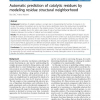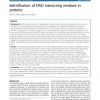420 search results - page 8 / 84 » A graphical model for predicting protein molecular function |
BMCBI
2010
13 years 8 months ago
2010
Background: Prediction of catalytic residues is a major step in characterizing the function of enzymes. In its simpler formulation, the problem can be cast into a binary classific...
HPDC
2010
IEEE
13 years 8 months ago
2010
IEEE
A common task in biological research is to predict function for proteins by comparing sequences between proteins of known and unknown function. This is often done using pair-wise ...
BMCBI
2010
13 years 8 months ago
2010
Background: The knowledge about proteins with specific interaction capacity to the protein partners is very important for the modeling of cell signaling networks. However, the exp...
BMCBI
2010
13 years 8 months ago
2010
Background: Small molecular cofactors or ligands play a crucial role in the proper functioning of cells. Accurate annotation of their target proteins and binding sites is required...
BIRD
2007
Springer
14 years 1 months ago
2007
Springer
The coiled-coil protein domain is a widespread structural motif known to be involved in a wealth of key interactions in cells and organisms. Coiled-coil recognition and prediction ...


